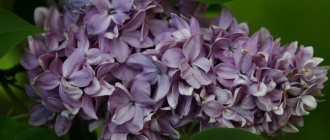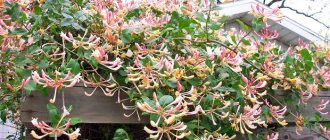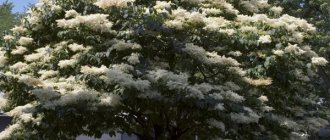General description of Chinese lilac
The Chinese lilac shown in the photo was discovered in the 18th century in the botanical garden of the French city of Rouen, and it still remains a mystery why it is called that way, because this species does not grow in natural conditions.
The external resemblance of the shrub to the Persian lilac prompted breeders to think about the hybrid origin of the species, which was subsequently proven by L. Henry and E. Lemoine during testing by artificial crossing of various species.
Thus, it has been established that Chinese lilac (Syringa x chinensis), an ornamental perennial garden shrub that belongs to the Olive family, was obtained by crossing common and Persian lilacs. The hybrid eventually received an improved bush shape, lush flowering, resistance to dry periods, improved rooting and survival rate.
The bush can be 5 m in height. The diameter of the trunks is smaller than that of the common lilac. The graceful branches of the bush hang down, its crown is neat, up to 3 - 4 m wide.
The elongated leaves are pointed at the ends. They are not very large in length - about 4 - 7 cm, located oppositely. Small tubular flowers form panicles 10–16 cm long and 2 cm wide. The inflorescences resemble a fox's tail or a pyramid.
How Chinese lilac blooms
Chinese lilac blooms magnificently, forms many inflorescences, and in this way it is similar to ordinary lilac. It begins in May - June and pleases the eye for another two weeks. Its inflorescences are varied - white, purple or pink. In addition, this species has forms with simple flowers and with double flowers, always with a fragrant aroma.
Syringa chinensis Willd. — Chinese lilac
Chinese lilac . Originated in horticultural culture, discovered in the Rouen Botanical Garden (France), around 1777, a natural hybrid. The hybrid origin was established by artificial crossing of the original species by breeders L. Henry, later E. Lemoine. The name Chinese lilac is clearly erroneous, since its morphological characteristics are similar to Persian lilac, differing from the latter mainly in the shape and greater height of the bush (3-6 m), upright, thicker shoots (but much thinner than those of the common lilac) . Annual shoots are brownish-gray, with large light lentils. The leaves are small, 4-7 cm long, 2-4 cm wide, ovate-lanceolate; gradually sharpening at the apex; on short, thin petioles; similar to the leaves of Persian lilac, but lighter; dense; semi-leathery. The flowers are pinkish-lilac, up to 2 cm in diameter, very fragrant, corollas with a thin tube and oval, pointed, flat petals. Inflorescences are formed from three to ten pairs of lateral buds, often forming complex panicles up to 60-80 cm long, reminiscent of a fox tail. Individual panicles reach a size of 16x9 cm, loose, ovoid, slightly drooping. It blooms profusely, regularly, simultaneously with common lilac for 12-15 days. Fruiting usually does not occur. In Moscow conditions, the ends of the shoots often partially freeze. It develops well in the forest-steppe zone of Ukraine. Can be successfully cultivated in Belarus, the Baltic states, Transcaucasia, and Central Asia. Chinese lilac is the most decorative among the lilac species, especially during the flowering period. It is highly drought-resistant, but is demanding on soil fertility. Easy to propagate by green cuttings, grafting, layering. In cultivation there are varieties with white, purple, light lilac flower colors and double forms.
Other species and hybrids Among the numerous species of lilac, there is a group of the most decorative ones, which, along with the common lilac, are of significant interest for landscaping. These are Hungarian lilac, hairy lilac, Zvegintsova lilac, Amur lilac and its varieties Japanese lilac, Chinese lilac and Persian lilac. The biological and morphological characteristics of these species have been widely studied in recent years. Development and structure. The first stages of development of seedlings of the listed species are very similar to those of common lilac. At first they grow very slowly, not exceeding 3 - 6 cm in height in the first year by autumn. All species are also characterized by long and periodic (intermittent) growth in the first growing season. Hungarian lilac and hairy lilac grow most intensively in spring and autumn; ligustrins (Amur lilac and Japanese lilac), like common lilac, in July - August. Growth continues until the end of September - beginning of October. Plants of all types shed their leaves; some of them remain only in the Amur lilac. By winter, the seedlings have time to ripen and are not damaged by frost. In the second year, seedlings of these species grow much faster than common lilac and reach a height of 20-30 cm. Most plants retain the ability to renew growth a second time. In all species, branching of the aerial part begins - erect tillering shoots are formed from dormant buds in the axils of the lower leaves of the main shoot. Hairy lilac and Zvegintsova lilac are especially prone to branching; Amur lilac has weaker branching. All lilacs, except Ligustrin, have a fibrous, abundantly branched root system; at one year of age, its volume exceeds the above-ground part by five to eight times, at two years of age - by two to three times. The lateral roots are more developed than the main one; Absorbing roots for the most part are located shallowly. The Ligustrin root system is characterized by weaker growth and fewer active roots. From the third year of life, the growth of seedlings increases significantly, although the period of shoot growth is reduced. By the autumn of the fourth year, young bushes of most species reach a height of 70-75 cm, and ligustrins - even more than 1 m. Species of the section hairy lilacs and ligustrins do not form underground shoots, therefore the natural formation of the bush occurs in the same way due to an increase in the number of renewal shoots in base of the main trunk (basal shoots). Species of hybrid origin (Chinese lilac and Persian lilac) are characterized by the development of rhizomes, so in terms of the structure of the bush they are close to common lilac. Representatives of the section of hairy lilacs generally bloom earlier than common lilacs, i.e. in the third or fourth year; ligustrins - later - on the fifth to eighth. Generative buds in all species are formed on annual shoots in the upper part of the bush. Ligustrin and species of hybrid origin are characterized by the death of the shoot apex, as in the common lilac, so their generative buds are lateral; in the hairy lilac section, the shoot always ends with an apical bud, which can be vegetative or generative. In Hungarian lilac, hairy lilac and Zwegintz lilac, inflorescences are formed from apical buds and one to three pairs (in Zwegintz lilac - three to five pairs) of lateral buds; in ligustrins - from two to four, and in species of hybrid origin from five to seven pairs of lateral buds. Generative buds in all these species are laid and develop in the year preceding flowering, after flowering ends and shoots grow in length. Only the Hungarian lilac in some years produces a small number of buds in the year of flowering. The process of formation of generative buds ends in the spring of next year. In Hungarian lilac, hairy lilac and Zwiegintsov lilac, the generative buds are mixed, that is, in addition to the inflorescence, they contain two to four pairs of leaves. Therefore, in spring, the nature of the foliage of shoots in these species creates the impression that the inflorescence develops from the apical bud of the shoot of a given year's growth. The structure of flower buds in ligustrin, Chinese lilac and Persian lilac is the same as in common lilac. The timing of the onset of individual phenophases in the species of the hairy lilac section is delayed by 10-15 days compared to the common lilac (with the exception of the phase of ripening of fruits and seeds), so their inflorescences never fall under spring frosts. Flowering begins at the end of shoot growth (the latter lasts about a month). The growth of Amur lilac shoots continues for about two months. Flowering occurs after it ends. The phenophases of Chinese lilac, Persian lilac and common lilac almost coincide, but the period of secondary growth of shoots in the first two lasts until late autumn. Like common lilac, these species bloom during the period of the most active growth of shoots. The growing season of all species varies depending on climatic conditions. The shortest growing season is for Amur lilac and hairy lilac; the longest (approaching the growing season of common lilac) is in species of hybrid origin. Lilacs bloom sequentially, one type after another, and last for almost two months. In Moscow conditions it lasts from mid-May to early July. All species bloom annually and profusely. The Chinese lilac has the most abundant blooms. The beginning of the flowering of Hungarian lilac approximately coincides with the flowering of late varieties of common lilac (Godisho). Amur lilac blooms in the second half of June. The average duration of flowering of some types of lilac (in days) is as follows (species are arranged in order of flowering): lilac Chinese lilac Persian lilac Hungarian lilac hairy lilac Zwegintz lilac Japanese Amur lilac All species bear fruit abundantly, starting from the first year of flowering. The fruits ripen in August–September. You should not be late in collecting seeds, as the boxes already crack in October-November and the seeds begin to spill out. Species of hybrid origin do not produce seeds. Sometimes they appear in small quantities on Persian lilacs. Hairy lilacs lose their leaves in mid-October; species of hybrid origin go into winter with green leaves. The winter dormancy period for all these species is relatively short and ends in November - January, with the exception of Zvegintsov lilac, which emerges from dormancy only in early April. Mature plants form very strong bushes, especially under favorable climatic conditions. In Moscow, 15-20-year-old bushes of Hungarian lilac, hairy lilac and Zvegintsov lilac reach a height of 2.5-4 m, Chinese lilac and Persian lilac - 2-2.5 m, ligustrin - 5-6 m. Life expectancy in the culture of Hungarian lilac, hairy lilac and Zvegintsov lilac, as well as ligustrin has not been determined. In the former Main Botanical Garden (Moscow), bushes of these species at the age of 35-40 years do not yet show signs of aging. Species of hybrid origin, the original forms of which are related to the common lilac, also bloom beautifully up to 15 years, and then the central part of the bush begins to die off. Noteworthy is the absence of large-flowered and double forms in the section of hairy lilacs. N.K. Vekhov (1953) explained this by the relative youth of their culture compared to common lilac and less attention of breeders to them. Indeed, recently, when lilac species have become more actively studied, it has been possible to identify new interesting forms in the downy and hairy lilac sections. Requirements for growing conditions. Temperature. In species of hybrid origin, due to the long growth period, shoots very often freeze in winter. At especially low temperatures, their bushes can freeze to the ground. Hungarian lilac and hairy lilac are distinguished by high winter hardiness. Young shoots of lilac Zweginsova and ligustrin are damaged by severe frosts. Hungarian lilac is as heat-resistant as common lilac. Hairy lilac and Japanese lilac are quite heat-resistant. The lowest heat resistance is found in Zwiegintsov lilac, Chinese lilac and Persian lilac, especially in the second half of summer. Light. Chinese lilac and Persian lilac are very light-loving and bloom only in open places; other types remain decorative even with slight shading. It has been noted that hairy lilac develops better in partial shade. Undemanding in terms of lighting, Hungarian lilac can be used as a tub crop for landscaping large premises in enterprises. Moisture. The Persian lilac is the most resistant to lack of moisture. Chinese lilac, hairy lilac and Zvegintsova lilac are also distinguished by high drought resistance; Hungarian lilac and Amur lilac are quite resistant. The Japanese lilac suffers the most from drought. All species develop best on moderately moist soils. Hungarian lilac, hairy lilac and Amur lilac grow well in waterlogged areas. In this regard, Hungarian lilac can be used as a rootstock for grafting lilac varieties on damp soils, where the common lilac gets wet. Soil composition. All species grow well in any soil. The only exception is Chinese lilac. However, they achieve their highest decorative properties on fertile, neutral or slightly alkaline soils. Hungarian lilac prefers slightly acidic soils, as with excess lime it suffers from chlorosis. Persian lilac tolerates high salt content in soils. Thus, most types of lilac are hardy and resistant to unfavorable environmental conditions, so they are perfect for landscaping in urban areas.
Forms and varieties of Chinese lilac
Chinese lilac has several forms, both popular among gardeners and not so popular, each of them has its own distinctive features.
- Chinese lilac Saugeana (Saugeana, or Sodzhina). This is the most common form of this type. The diameter of the spreading crown of the bush is 3 m, the height also reaches 3 m. Large purple inflorescences of Chinese lilac Nuzhena look good against the background of green foliage;
- Chinese lilac Duplex, or Double. This is also a small bush, the maximum height of which is 2, less often - 3 m. A distinctive feature of this form is double flowers of a rich burgundy shade;
- Chinese lilac Metensis. The bush with an ovoid crown is larger in height than previous forms - 3.5 m. The panicles of pale purple inflorescences are large: 15 - 16 cm in length and up to 9 cm in width;
- Chinese lilac Alba Dieck - characterized by showy white flowers;
- Chinese lilac Bicolor (Lemoine) H. Jaeger. Although this variety is not widespread, its flowers are very rare and extremely beautiful - two-colored.
Synonyms: Syringa chinensis Bunge Mém., Syringa × chinensis Willd., Marley, Lilac × media (Dum.Cours.) Dum.Cours., Lilac × persica var. dubia (Pers.) Jacques & Hérincq, Lilac × persica var. rotomagensis (Renault) Mirb., Lilac × rotomagensis (Renault) Poit. & Turpin, Lilac × varina Dum.Cours., Liliacum × rothomagen Renault, Syringa × correlata A.Braun, Syringa × dubia Pers., Syringa × dubia f. alba Dippel, Syringa × media Dum.Cours., Syringa × metensis Dippel, Syringa persica var. ovata Stokes, Syringa × rotomagensis (Renault) A.Rich., Syringa × rotomagensis var. alba G.Kirchn., Syringa × rotomagensis var. bicolor Lemoine, Syringa × rotomagensis var. saugeana Loudon, Syringa × rubra Lodd. ex Dippel, Syringa × saugeana (Loudon) Leroy, Syringa × sibirica Loudon, Syringa × speciosa DC.(unused), Syringa × vulgaris var. dubia (Pers.) Franch.
Chinese lilac (Syringa chinensis Willd.) is a species of deciduous shrub from the Olive family (Oleaceae). The hybrid, discovered in the Rouen Botanical Garden (France) in 1777, originated from crossing the Persian lilac and the common lilac (S. persica x S. vulgaris). It was first described by the German botanist Carl Ludwig Wildenow in 1796 in his Berlinische Baumzucht. In culture since the beginning of the 19th century.
It is an upright growing shrub 3-6 m in height with a broadly ovate or pyramidal crown shape. The bark is gray, flaky. The branches are thin, erect, arched at the top. The shoots are light green in color, later becoming red-brown, glabrous, covered with thick, protruding light lentils.
The leaves are 4-8 cm long and 2-4 cm wide, ovate or ovate-lanceolate, wedge-shaped at the top, with a pointed apex and a rounded or broadly wedge-shaped base, glabrous, semi-leathery, bright green, slightly lighter below. The petioles are thin, up to 1.2 cm in length.
The flowers are large, up to 1.8 cm in diameter, collected in loose, slightly drooping panicles up to 17 cm in length and 9-10 cm in width, regularly rounded and pyramidal in shape. They are formed from (1) 3-10 pairs of axillary lateral buds on the shoots of the previous year, forming complex panicles, reaching 30-40 (80) cm in length in good conditions. The flowers are lilac, reddish or lilac-reddish in color, with a strong pleasant aroma. The corolla is 0.8-1.2 cm in length, the tube is narrowly funnel-shaped, the limb blades are elongated-oval. It blooms very profusely, from May to June, for about 2-3 weeks, almost simultaneously with the common lilac. The species is practically sterile.
Shapes:
- Syringa x chinensis f. duplex. - double purple flowers.
- Syringa x chinensis f. metensis. - pale purple flowers.
- Syringa x chinensis f. Saugeana. - light purple flowers.
- Syringa × chinensis f. alba Dieck – white flowers
- Syringa × chinensis f. bicolor (Lemoine) H.Jaeger – two-color flowers
Frost resistance zone: 4a (-34°C).
Location: prefer places sheltered from strong winds with good lighting, but can also grow in the shade (does not bloom). Does not like low, swampy or temporarily flooded places in spring (autumn). It prefers moderately moist, fertile, structural, humus soil with a waterproof soil horizon. Loves loamy soil, black soil, with organic or mineral fertilizers. Recommended pH 6-7; on acidic soils, lime must be added. It is highly drought-resistant.
Planting : recommended at the end of August and until the beginning of September. Bushes transplanted with growing buds take root very poorly and produce virtually no growth in the first year after planting. Can also be planted in mid-July. The root collar after planting should be at a level of 3-4 cm above the soil. When planting, 15-20 kg of humus or compost and 200-300 g of wood ash are added to the leaf soil.
Care: apply mineral fertilizers or ash solution 2 times a season - in the snow and after flowering. 1 per year, 1 bucket of mullein or bird droppings is also added under each bush, which must be covered with earth in a circular groove 20-30 cm deep at a distance of 50-60 cm from the trunk. The trunk circle is loosened 3-4 times a year and sprinkled with peat or leaves for the winter, in a layer of up to 10 cm. It is recommended to wrap standard trees in burlap for the winter in the first 2-4 years after planting.
Pruning: to form a bush, it is necessary to leave the first pair of buds at a height of 12-15 cm; for standard forming on the trunk of a standard, it is necessary to remove the buds at a height of 50-80 cm, leaving only 5-6 upper pairs, cut off the top of the shoot above the last one and The top pair is left with only 1 kidney. For 3-4 years after planting, formative pruning is carried out, leaving 5-10 skeletal, most regular and beautiful branches, and the main shoot is shortened. Formed bushes are thinned out in February-March. After flowering, trim off the faded inflorescences. It is recommended to cut up to 2/3 of flowering shoots for bouquets, which improves flowering.
Reproduction: does not produce seeds. Propagates well by grafting, green cuttings and layering.
Diseases: Gray rot, powdery mildew, rust, wilt.
Pests : nematodes, spider mites, beet aphids, scale insects, bedbugs, snails and slugs, rodents (vole mouse, gray rat).
Use: the most decorative species among all lilacs. Used as a tapeworm or in small groups in easily visible places, in compositions with other trees or shrubs, to create living, free-growing hedges, in spacious gardens, to create continuous thickets; low-growing species are planted in the background of flower beds or rocky hills. It is used for cutting and forcing branches cut in the fall after the formation of flower buds.
How does Chinese lilac reproduce?
There are several ways to propagate a bush, using:
- Seeds;
- Layers;
- Privoev;
- Cherenkov.
Gardeners rarely use seeds for propagation, because fruits are not always available. For better germination, it is necessary to carry out stratification - keep the seed material in moistened sand in the refrigerator for 2 months. In early spring, it can be planted in a box with soil to a depth of no more than 1.5 cm. Seeds can sprout within 2 weeks or after several months. Seedlings dive 2 weeks after they sprout. It is important that the air and soil are well warmed up; then it is time to transfer the seedlings to the site.
One of the common methods of propagation is Chinese lilac layering. In spring, an annual shoot is tied with copper wire in two places: at the base and at a distance of 80 cm from it. The bark must not be damaged. The branch should be placed in a groove near the bush, sprinkled with earth (except for the top). As soon as the new shoots reach a height of 15 - 17 cm, they are spudded. In autumn, the cuttings are separated from the bush.
In the spring, gardeners also quite often graft a bush - this is the second common method of propagation. The cuttings are prepared in early spring and kept in the refrigerator until grafting. The scion is wrapped in a bag. It is removed after the buds begin to swell.
Advice! Annual stems of common or Hungarian lilac are suitable as rootstocks.
Propagating Chinese lilacs using cuttings is not very easy because they do not take root well. Young shoots (preferably annual ones), which are cut directly during flowering or after, are suitable for this purpose. The cuttings are rooted in a greenhouse in calcined soil made of peat and sand. It is important to cover the shoots. After about 2 months, the cuttings will take root, and in the spring the plant can be planted on the site.
Reproduction
This ornamental plant is propagated by layering, cuttings and grafting. Reproduction using the first method is the simplest; it makes it possible to grow a strong seedling with a well-developed root system, fully prepared for planting. In the spring, you need to make a small furrow near the lilac bush, bend a branch to it and cover it with earth, leaving only a few shoot ovaries at the top. Already in the fall you will receive a young seedling that can be replanted next year.
Cuttings are a more complex method, since the shoots do not take root well, so everything must be done with special care. Cuttings are cut when the bush is in bloom; annual stems with 2-3 nodes are selected. Cuttings and soil should be disinfected with special disinfectants and left to take root in boxes for two months, covered with film or cut plastic bottles. Planted in open ground in the spring.
Propagation by grafting is quite common, although such seedlings are sensitive to cold. An ordinary or Hungarian lilac is used as a rootstock; this manipulation is carried out in the spring, although the cuttings are cut in February and stored in the refrigerator. Before budding, all branches of the rootstock are cut off, leaving only 15-20 cm, the root shoots are removed and watered generously for several days. The trunk of the rootstock is split with a special knife, then a shoot of Chinese lilac, sharpened with a wedge, is inserted there. The grafting site is secured with tape, the damage is treated with garden varnish, and everything is wrapped in a bag, which is removed when the buds on the scion swell.
Propagation by seeds of this hybrid is generally not practiced, since Chinese lilac very rarely bears fruit.
Growing such an ornamental shrub in your own area will not be difficult, you just need to take into account some of the nuances of caring for it. And then you will be able to fully enjoy the fragrance and beautiful flowers of the extraordinary Chinese lilac.
To learn how to plant lilacs correctly, watch the following video.
Planting and caring for Chinese lilacs
Chinese lilac is quite winter-hardy and drought-resistant. But some nuances associated with planting and further care still need to be observed, because it is not for nothing that this species does not grow in the wild.
Chinese lilac - planting and care in the photo:
Recommended timing
With the exception of certain conditions, for the bush propagation methods described above, the optimal period for planting Chinese lilac is considered to be the second half of July - the beginning of September. At other times, the bushes will take root worse, will hardly give good growth and will not bloom for several years.
Site selection and soil preparation
Choosing a suitable place for a bush in the garden is important. To do this, follow the rules:
- Chinese lilac preferably grows with access to the sun, and there should be a lot of light. If you place the bush in a shady place, it will bloom very modestly, and it is even possible that the buds will not bloom at all.
- The plant needs protection from strong drafts, but light ventilation is a must for the growth of Chinese lilacs.
- It is better to choose a place on a hill to avoid rotting of the roots due to stagnant moisture.
- Chinese lilac is picky about the type and fertility of the soil and loves humus. It is necessary that the soil is moderately moist and drained, with a neutral or slightly acidic pH value.
Advice! Before planting a bush, you need to dig up the chosen place two shovels deep, add a layer of humus and loosen it.
How to plant correctly
It is recommended to follow the following steps:
- Prepare the roots - remove weak and damaged ones. Cloudy weather or early morning is more suitable for planting.
- It is necessary to first dig a planting hole larger in size than the roots, along with a lump of earth: approximately 50 - 60 cm deep and wide.
Important! If you plan to place several plants nearby, it is worth considering that the distance between them should be about 2 - 3 m (the diameter of the crown of an adult lilac). - Drainage must be laid at the bottom of the hole. It can be crushed stone or expanded clay. Next, add some soil and fertilizer and place a Chinese lilac seedling. It is important to carefully distribute its roots throughout the hole.
- Then the seedlings need to be sprinkled with fertile soil and the surface compacted with your hands (no need to press hard).
- Water the freshly planted bush generously with water.
Planting seeds in open ground
This method is rarely used. It is more suitable for regions with a mild climate, where veins begin early.
Landing dates
Sowing can be done only after the air warms up well in the spring. Budleya is very sensitive to cold, so the soil should also be well warmed up. At first, it is better to cover the crops on top with non-woven material.
Choice of location and lighting
To sow seeds in open ground, it is better to first choose a temporary flower bed, where the seedlings will sprout and get stronger. And only after that plant the plant in a permanent place. It should be well lit during the day, protected from drafts and strong winds.
On a note! The shrub is not very picky about soil. The plant develops quickly and blooms profusely in areas with nutritious, well-drained soil. If its composition is poor, then before planting buddleia it is worth adding compost mixed with mineral fertilizer.
Landing rules
Loosen the area for sowing and level it so that there are no large lumps of soil. Make grooves 1-2 cm deep. Distribute the seeds evenly in them, lightly sprinkle with soil and water it. Cover the top of the crops with film or agrofibre. When the seedlings appear and grow stronger, they can be transplanted to a permanent location.
Growing rules
Chinese lilac is relatively unpretentious, but in order for it to bloom more luxuriantly and grow faster, it is worth adhering to a number of rules - watering, feeding, pruning and preparing for winter. Then the culture will decorate the site for many years.
Watering schedule
Chinese lilac can withstand drought, so in summer it is recommended not to water it very often and not too much: the plant gets enough rainfall. But during the growing season and active flowering of lilacs, a large amount of water is needed.
What can you feed?
In the first 2 - 3 years, it is not necessary to fertilize the plant: for growth and development, it has enough minerals added during planting. Next, the bush should be fed with nitrogen fertilizer (60 g per bush). Slurry is also suitable; you need to add about 2 buckets of it per plant. Nitrogen fertilizers improve the color of leaves and activate shoot growth.
About once every 2 years, the plant is fed with double superphosphate and potassium nitrate (35 g per bush).
Mulching the soil
The trunk circle of Chinese lilac is mulched with peat and rotted leaves. This is done to protect the roots from overheating. It is enough to loosen the soil 3 - 4 times a season to a depth of 7 - 8 cm. It is important not to damage the roots. As an alternative, there is another option - to plant small perennial plants under the lilacs. They will naturally loosen the soil.
Pruning Chinese lilac
Pruning ennobles the bush or gives it a beautiful shape, making it immediately look well-groomed. It is recommended to do this three years after planting. It is better to do a haircut in early spring, before the buds swell. It is necessary to remove weak or damaged branches every year.
In addition, pruning rejuvenates the bush and sets the correct shape of the crown. In this case, you need to leave only 5 or 10 of the healthiest and straightest stems.
Important! In order for lilacs to bloom profusely every season, you must remember to cut off 2/3 of the inflorescences annually.
Preparing the bush for winter
It is recommended to cover young shrubs for the winter. This should be done only when cold weather sets in, but not before. The root circle is covered with a dense layer of 10 cm of fallen leaves and peat.
Bushes growing in the middle zone, in the Urals and even the Moscow region, should be covered for the winter, since at very low temperatures there is a risk of shoots freezing.
Application in landscape design
This very neat, beautiful and spectacular plant can decorate a garden area on its own, for example, towering on the lawn, or become part of a composition with other plants.
A significant advantage of Chinese lilac, often used in gardening, is its powerful, branched root system. Due to this, the shrub stands securely in the ground and helps strengthen creeping slopes or loose soil.
Chinese lilac is also suitable for hedges. Fencing made from multi-stemmed shrubs is quite dense and beautiful.
Pests and diseases
Chinese lilac is a fairly resilient crop, but some diseases and pests can overcome it, in particular:
- Bacterial necrosis. Accompanied by a change in foliage color from green to gray. The shoots turn brown. To prevent this, it is recommended to thin out the crown to ventilate the lilac.
- Bacterial rot. The disease affects the leaves, flowers, shoots and buds of Chinese lilac; they gradually dry out. You can cure lilacs. To do this, you need to spray the bush 3 or 4 times with copper oxychloride at intervals of 1.5 weeks.
- Powdery mildew. The leaves are covered with plaque. It is necessary to cut off the infected areas and spray the bush with a fungicide. In spring, it is better to dig up the soil with bleach (100 g/m2).
- Verticillium. The leaves curl and their surface is covered with brown spots. The bush dries out quickly, starting from the top. The affected plant must be treated with a special solution - add 100 g of soda ash and laundry soap to 1.5 buckets of water.
In addition, the shrub can be disturbed by hawk moth, leaf miner, lilac moth, as well as bud and leaf mites. It is necessary to spray the plant with appropriate preparations.











